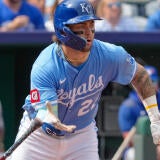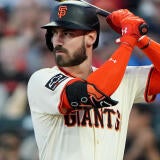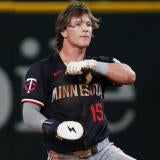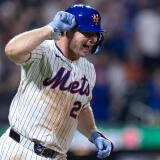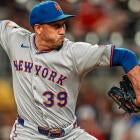Fantasy baseball waiver wire: Connelly Early among top adds and standout performances from Tuesday's action
Plus, why Chris Towers believes Daylen Lile is a useful piece in Roto leagues
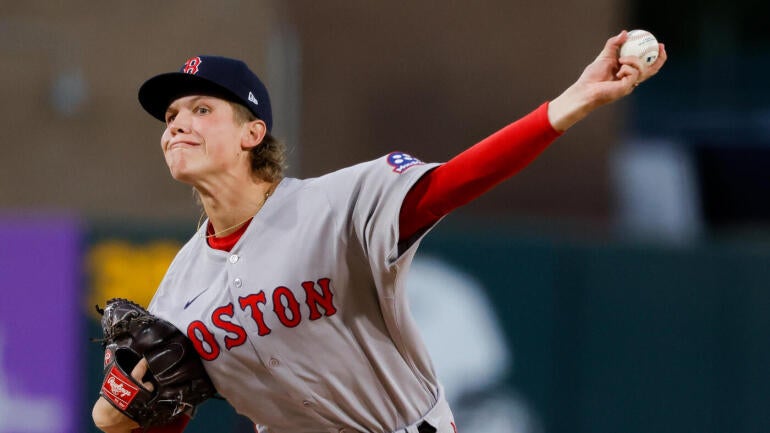
It's not always the most hyped young pitchers who make the biggest impact for Fantasy. And few of the young pitchers received less hype or made a bigger impact in their first start than the Red Sox's Connelly Early did in his MLB debut Tuesday.
And I mean "ever."
Early became the first pitcher since Freddy Peralta in 2018 – and just the 17th in MLB history – to strike out at least 11 in his MLB debut. That's incredibly impressive, and it's worth noting that there aren't a ton of flukes on that list, which includes names like Juan Marichal and Luis Tiant, but also more recently Tim Hudson, Stephen Strasburg, and Matt Harvey. Is it reasonable to expect Early to carry on that grand tradition?
Early gave us a lot of reason to think he might be able to in his debut, which featured a whopping 19 swings and misses on 90 pitches, including seven on his sinker, seven on his slider, three on his changeup, and two on his curveball. The depth of the arsenal from a left-handed delivery that generates a ton of extension – seven feet on release! – helps the stuff of the entire arsenal play up, and with a fastball that sat between 94-95, it's not like he's totally lacking in stuff.
We've seen a number of lefties emerge as unexpectedly productive Fantasy options this season, a phenomenon The Athletic recently covered, and it's not necessarily a huge surprise that a lefty with Early's stuff making his first start found success. What was especially impressive was in the fourth inning, when he ran into some trouble with a bases-loaded jam, only to get out of the jam with consecutive strikeouts to end the trouble. Then he went out for the fifth and struck out two more to end his night.
It wasn't totally clear if Early was up for good or just for a spot start, but I think this performance is going to force the Red Sox's hands. They have a decent top of the rotation, but they've been trying to find the right combination for the back end of the rotation, with fellow rookie southpaw Payton Tolle putting together an up-and-down first couple of starts. Early certainly has a chance to stick around, and coming off a 2.83 ERA and 31% strikeout rate at Triple-A this season, it doesn't seem like he has much development left.
Early is a big developmental win for the Red Sox along with Tolle, and I don't see much reason why they won't ride with both in the rotation the rest of the way. That might only amount to a couple more starts, but that could include two starts next week, against this same Athletics team, plus a middling Rays lineup. Recent starts from some of those other hyped young pitchers show that even a big debut doesn't guarantee anything beyond that, but with how impressive Early looked in his debut, I think you probably need to just add him now and see what happens.
Wednesday's top waiver-wire targets
Daylen Lile, OF, Nationals (15%) – In a season where not a whole lot has gone right for the Nationals, there's Lile, an unsung outfielder who has spent the past month-plus racking up hits. He had two more Tuesday against the Marlins for his sixth multi-hit effort in just eight September games, and he is now hitting .339 since the start of August with three homers and four steals. There isn't much in Lile's minor-league track record to suggest he's a long-term answer in the Nationals outfield, though he did hit .328/.377/.503 across Double-A and Triple-A before his promotion, so maybe he just took a leap this season. The underlying numbers do back it up, with a contact-heavy approach leading to a .303 expected batting average and enough speed to be a useful source of steals. In Roto leagues, Lile looks like a useful piece for the stretch run.
Moises Ballesteros, C, Cubs (12%) – I don't think it's especially likely that Ballesteros is going to get enough playing time down the stretch to matter for Fantasy, but it does seem noteworthy that it was the catching prospect who was called up to replace outfielder Kyle Tucker, rather than outfielder Owen Caissie. Ballesteros wasn't in the lineup for Tuesday's game, with Seiya Suzuki still in his normal DH spot – and that's really the only place Ballesteros has a chance to play now that Carson Kelly is showing signs of life again. So, again, I don't really expect Ballesteros to play much. But even now, the bar for Fantasy relevance at catcher is low enough that a talented hitter can clear it without being an everyday player, so let's keep an eye on the next few games to see if he gets a chance. A top prospect and career .303/.369/.466 hitter at Triple-A, Ballesteros is certainly talented enough to be worth getting excited about.
Shawn Armstrong, RP, Rangers (20%) – It sure seems like Armstrong is just the Rangers closer now. He picked up his eighth save of the season and fifth in the past three weeks Tuesday and has remained a very effective pitcher for the Rangers, putting up a 2.51 ERA for the season. I think Brad Keller would be preferable if he emerged as the Cubs' Danny Palencia replacement, but if you need saves right now, Armstrong is probably the better bet with the job security he has.
Joey Cantillo, SP, Guardians (14%) – Cantillo is on a nice little run, with just three runs allowed in his past four starts after he went eight shutout innings against the Royals Tuesday. How's he getting it done? Well, it starts with that ridiculous changeup, which generated eight whiffs Tuesday and which has a 51% whiff rate for the season to go along with a .240 xwOBA when hitters do manage to make contact with it. And then there's … well, that's about the extent of the things we can point to that make Cantillo stand out, but it might be enough. He has a 10.3 K/9 for the season with his 3.36 ERA backed up by a solid 3.57 FIP. Cantillo is RP eligible in CBS Fantasy leagues and might be in line for a two-start week next week; if not, he'll make one start against the Tigers. I don't love the matchup, but he's a viable streamer for that RP spot if you need one.
Here's what else you need to know about from Tuesday's action around MLB:
Monday's standouts
Cade Horton, Cubs @ATL: 6.1 IP, 4 H, 1 ER, 0 BB, 2 K
Look, obviously, a sub-1.00 ERA in the second half is unsustainable. You shouldn't need me to tell you that. What is also obvious is that Horton is an extremely talented young pitcher, so seeing him enjoy some level of success isn't exactly surprising. But if you're looking at this run and seeing signs of a future ace, I can't quite get there.
Horton just isn't missing enough bats (just three whiffs in this one!), and while I do think there's some funkiness to his approach that helps him avoid bats, it's not necessarily showing up in the underlying data. His fastball moves more like a cutter, except it comes in at 95-96 mph, and while it doesn't miss bats the way Corbin Burnes' primary used to, I can imagine that can be a pretty uncomfortable experience for hitters. Except Horton's underlying numbers don't really suggest he has outlier contact suppression skills either, with a roughly average .362 xwOBA on contact.
Add it all up, and I'd probably project something like a high-3.00s ERA for Horton in 2026, albeit with both plenty of upside and downside risk, given his injury history. He feels like someone you draft around the No. 50 SP, but I suspect he'll go higher than that in most drafts.
Ranger Suarez, Phillies vs. NYM: 6 IP, 1 H, 0 ER, 3 BB, 12 K
Now this is how you have a contract year. Suarez is shedding the "late-season collapse" narrative in real time, and Tuesday was his third double-digit strikeout effort in his past five starts – he had just two in his entire career prior to this stretch. Suarez isn't quite as good as he's looked lately, but as I've pointed out before, he does have a 3.19 ERA over the past five seasons combined, so it's not like this is a total fluke. He's going to be one of the most interesting pitchers to watch in free agency (can he get a $100 million contract? I think so), and in 2026 Fantasy drafts, too. I think he should probably be valued somewhat like Seth Lugo was coming into this season, with less upside in terms of volume but more certainty that he'll be good.
Emmett Sheehan, Dodgers vs. COL: 7 IP, 3 H, 1 ER, 1 BB, 9 K
There's been some uncertainty surrounding the role and usage for Sheehan, but he has managed to look absolutely locked in despite that. Tuesday was his third start of at least six innings in his past four, something he failed to do all season before that point. He has 43 strikeouts to just nine walks in 34.2 innings since the start of August with a 3.12 ERA. I'm a believer in Sheehan's talent and have been for some time now, so I'm inclined to just buy into his swing-and-miss skills, though the Dodgers' rotation depth and the fact that he's sixth in the pecking order might lead to consistent headaches. But he's going to be a big-time breakout candidate for 2026 if it looks like he's going to remain in the rotation.
George Kirby, Mariners vs. STL: 4 IP, 7 H, 3 ER, 2 BB, 2 K
Kirby hasn't been right all season. That's obvious from the overall production, with his ERA sitting at a career-worst 4.56 mark, but I think another sign of it has been his inconsistent offspeed usage. Kirby settled on a very good splitter as his number four pitch over the past couple of seasons, but there have been long stretches this season – including Tuesday – when that pitch has totally disappeared. Sometimes it has been replaced by a changeup, but just as often, he just hasn't had any softer stuff to offer to hitters. Kirby's velocity has remained mostly fine all season, but he has lowered his arm slot, potentially as a result of the shoulder issue that cost him most of the first two months of the season. I'd bet his primary focus this offseason is going to be on raising that arm slot and getting that splitter back, and that'll be something to watch in spring training as he tries to get back to his pre-2025 form. I'm mostly in on Kirby as a bounce-back candidate for 2026, but it's something to watch.
Kyle Bradish, Orioles vs. PIT: 7 IP, 4 H, 1 ER, 2 BB, 6 K
Bradish didn't have his best stuff in this one, but the nice thing about facing the Pirates is you can still have a good start with your B game. He left too many sliders up, but the pitch is good enough that the Pirates couldn't really do anything. He ended up with just eight whiffs on 81 pitches, and his velocity was down a touch, but I remain very optimistic about Bradish moving forward. He's a useful pitcher for his final few starts, but he'll be a big-time breakout candidate for 2026 after getting a normal offseason for the first time since 2023.
Michael King, Padres vs. CIN: 5 IP, 3 H, 2 ER, 1 BB, 2 K
All things considered, we'll take this outcome from King, who has made just one other since late May. He was pitching about as well as ever before the shoulder injury in May, and hopefully he can close the season out with a couple more good starts (and maybe a nice, healthy, productive postseason push), both for his sake – King is a free agent – and to give us something to be optimistic about in 2026. King is clearly a very good pitcher, but he's also 30 and has only gotten through one healthy season as a starter, which makes it tough to know if you can trust him. I'm thinking he drops to around the SP30 range in drafts, but the next few weeks will play a big part in that.
Spencer Strider, Braves vs. CHC: 6 IP, 6 H, 2 ER, 3 BB, 8 K
Strider has been putting in extra work in between starts, and maybe it's starting to pay off. His fastball has had a bit better shape lately, and this is one of his best starts of the season, which is needed. He still doesn't have his pre-injury fastball, which remains the biggest thing he needs to work on for 2026, because the slider and even curveball have remained extremely effective pitches. Clawing back a bit of velocity with a normal, healthy offseason would be huge, and if Strider comes out next spring pumping in high-90s heaters, I think we're going to see a lot of hype build around him. For now, I'm thinking of him as someone to draft in that SP30 range, where we tend to stick talented but questionable pitchers once the true aces are off the board. I do feel pretty confident he'll be better than 2025 – many pitchers often need the first season back from elbow surgery to get their legs back under them – but can he get back to being a true ace? That's a much bigger question mark.
Casey Mize, Tigers @NYY: 6 IP, 4 H, 2 ER, 0 BB, 8 K
This is an excellent start from Mize, and to be honest, I mostly responded with a shrug. I just don't think he's all that good. Mize doesn't have great feel for spin despite having three different breaking balls, and his command isn't quite good enough to maximize what he does well. He's useful for Fantasy, but I don't think he's much more than useful, and his 3.83 ERA and 1.27 WHIP this season seem like a pretty good place to set expectations moving forward. That's late-round fodder, I think.
Noah Cameron, Royals @CLE: 7 IP, 6 H, 2 ER, 0 BB, 6 K
I can at least see the case for Cameron being something more than late-round fodder. Being a lefty helps in that regard, especially a lefty with a changeup and curveball that have been excellent at neutralizing the platoon disadvantage. The question for me is whether he can find a way to tap into more strikeout upside – the changeup and curveball miss bats well, and the slider is fine, but his sub-20% strikeout rate in the majors just isn't good enough to be a reliable long-term option. Cameron was a much more consistent bat-misser in the minors, so I'd like to see some signs of him getting that back down the stretch. A good sign to that end was the 16 whiffs Tuesday, including eight on the slider. I don't love using him against the Blue Jays, but let's keep an eye on this one for the final three starts.
Zebby Matthews, Twins @LAA: 4.2 IP, 7 H, 5 ER, 2 BB, 5 K
I want Matthews to be good. He does some really good stuff, most notably his 19.5% K-BB%, a mark only 15 qualifying pitchers have bested this season. His biggest issue, of course, is that he just gets hit way too hard when he allows contact. Sometimes pitchers can overcome that – Nick Pivetta finally figured it out this season, so there's hope for everyone! – but Cameron isn't really giving us reason to believe he's figuring that one out. You might be inclined to look at Matthews' .438 BABIP in this one as some bad luck, especially since each was just a single. But six of the seven had an expected batting average of .590 or better (the seventh was merely at .390), so it's hard to argue this was just bad luck. Quality of contact fluctuates a lot for pitchers, so some improvement wouldn't be totally unexpected. But I'm at the point with Matthews where he needs to give me an affirmative reason to believe he's figured it out before I give him the benefit of the doubt.


